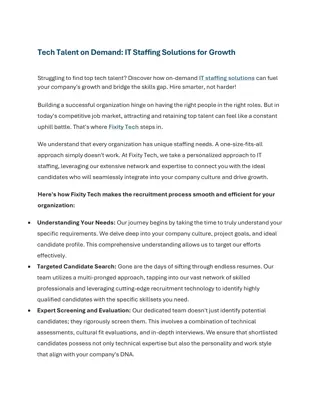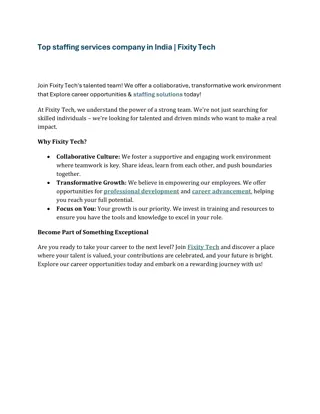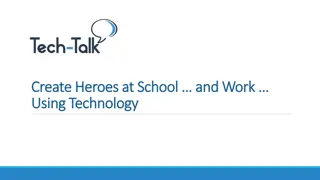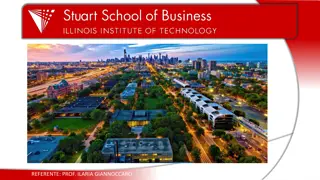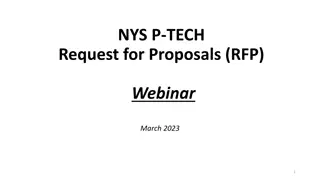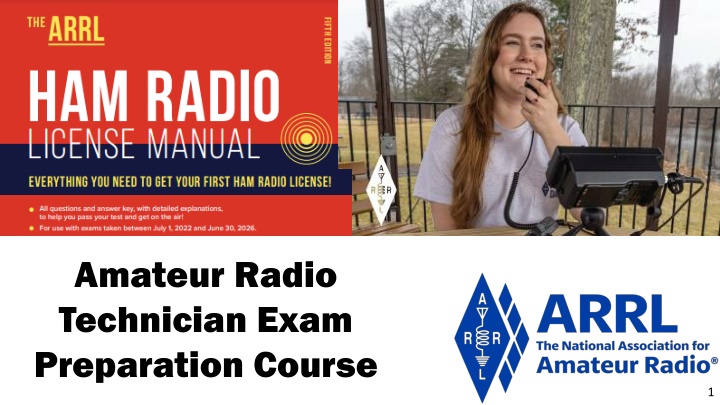
Amateur Radio Technician Exam Prep: Operating Regulations and Control Operators
Prepare for the Amateur Radio Technician exam with a focus on Operating Regulations, Control Operators, and Station Privileges. Learn about the responsibilities of control operators, identification rules, guest operating privileges, and more in this comprehensive course.
Download Presentation

Please find below an Image/Link to download the presentation.
The content on the website is provided AS IS for your information and personal use only. It may not be sold, licensed, or shared on other websites without obtaining consent from the author. If you encounter any issues during the download, it is possible that the publisher has removed the file from their server.
You are allowed to download the files provided on this website for personal or commercial use, subject to the condition that they are used lawfully. All files are the property of their respective owners.
The content on the website is provided AS IS for your information and personal use only. It may not be sold, licensed, or shared on other websites without obtaining consent from the author.
E N D
Presentation Transcript
Amateur Radio Technician Exam Preparation Course 1
Amateur Radio Technician Exam Prep Course Module 8 Operating Regulations 8.1 Control Operators 8.2 Identification 8.3 Interference 8.4 Third-party Communications 8.5 Remote and Automatic Operation 8.6 Prohibited Transmissions 2 2
Control Operators The control operator is a licensed operator who is responsible for making sure all FCC rules are followed The control point is wherever the control operator operates the transmitter The station licensee is responsible for designating the control operator All transmissions must be made under the supervision of a control operator The control point can be remotely located and connected by phone lines, the internet or a radio link 3 3
Privileges and Guest Operating A control operator may operate the station in any way permitted by the privileges of their license class Regardless of the station owner s privileges You may allow another amateur to use your station (guest operator) The guest may operate under your privileges as long as you re present If you walk away, the guest may operate only under his/her privileges (if unlicensed, they have no privileges) If you re the guest, and have a higher license class than the station owner, you may operate under your privileges Both the guest operator and station owner are responsible for proper operation of the station The control operator is responsible for the station s transmissions The station owner is responsible for limiting access to the station only to responsible licensees who will follow the FCC rules 4 4
Identification Your call sign is your identity on the air Identification rules apply at all times Unidentified transmissions (that is, no call sign) are not allowed Exception controlling a model craft To make a short transmission to test an antenna or make adjustments to your radio, just state/send your call sign Don t key the microphone and listen for the repeater s signal (kerchunking) Give your call sign at least once every 10 minutes during a contact and when the communication is finished If you are using phone, you are required to identify in English, even if communicating in another language FCC recommends the use of phonetics when you identify by voice You may give call sign by CW when communicating by voice 5 5
Tactical Calls Tactical call signs (or tactical IDs) help identify where a station is and what it is doing Can be used at any time, but are usually used in emergency and public service operation Allow consistent identification that streamlines communication based on function Regular identification rules apply give your FCC-assigned call sign every 10 minutes and at the end of the communication When a new operator takes over a tactical station, he/she gives their FCC-assigned call sign along with the tactical call 6 6
Self-Assigned Indicators When operating away from your home station, add information to your call sign so other stations are aware of your location FCC Part 97.119(c) says One or more indicators may be included with the call sign. Each indicator must be separated from the call sign by the slant mark (/) or by any suitable word that denotes the slant mark. If an indicator is self-assigned, it must be included before, after, or both before and after, the call sign. For example, on phone, KL7CC could identify as W3/KL7CC or KL7CC/W3, using stroke, slash or portable between the indicator and the call sign Indicator may not conflict with some other indicator specified in the FCC rules, such as /KT, /AG and /AE (upgraded license class) Indicator may not conflict with a prefix assigned to some other country 7 7
Test Transmissions Identification rules apply to on-the-air test transmissions Call sign must be given once every 10 minutes and at the end of transmissions Keep test transmissions brief to Avoid causing interference Keep from occupying an otherwise useful frequency Usual method of identifying during a test transmission Voice: Say K ILP testing CW / Morse Code: Send K ILP VVV 8 8
When may an amateur station transmit without a control operator? A. When using automatic control, such as in the case of a repeater B. When the station licensee is away and another licensed amateur is using the station C. When the transmitting station is an auxiliary station D. Never T1E01 D 97.7(a) 8-1 10 10
Who must designate the station control operator? A. The station licensee B. The FCC C. The frequency coordinator D. Any licensed operator T1E03 A 97.103(b) 8-1 11 11
What is an amateur stations control point? A. The location of the station s transmitting antenna B. The location of the station s transmitting apparatus C. The location at which the control operator function is performed D. The mailing address of the station licensee T1E05 C 97.3(a)(14) 8-1 12 12
What determines the transmitting frequency privileges of an amateur station? A. The frequency authorized by the frequency coordinator B. The frequencies printed on the license grant C. The highest class of operator license held by anyone on the premises D. The class of operator license held by the control operator T1E04 D 97.103(b) 8-2 13 13
When, under normal circumstances, may a Technician class licensee be the control operator of a station operating in an Amateur Extra Class band segment? A. At no time B. When designated as the control operator by an Amateur Extra Class licensee C. As part of a multi-operator contest team D. When using a club station whose trustee holds an Amateur Extra Class license T1E04 D 97.103(b) 8-2 14 14
When the control operator is not the station licensee, who is responsible for the proper operation of the station? A. All licensed amateurs who are present at the operation B. Only the station licensee C. Only the control operator D. The control operator and the station licensee T1E07 D 97.103(a) 8-2 15 15
Who does the FCC presume to be the control operator of an amateur station, unless documentation to the contrary is in the station records? A. The station custodian B. The third party participant C. The person operating the station equipment D. The station licensee T1E11 D 97.103(a) 8-2 16 16
What do the FCC rules state regarding the use of a phonetic alphabet for station identification in the Amateur Radio Service? A. It is required when transmitting emergency messages B. It is encouraged C. It is required when in contact with foreign stations D. All these choices are correct T1A03 B 97.119(b)(2) 8-3 17 17
When may an amateur station transmit without identifying on the air? A. When the transmissions are of a brief nature to make station adjustments B. When the transmissions are unmodulated C. When the transmitted power level is below 1 watt D. When transmitting signals to control model craft T1D11 D 97.119(a) 8-3 18 18
When are you required to transmit your assigned call sign? A. At the beginning of each contact, and every 10 minutes thereafter B. At least once during each transmission C. At least every 15 minutes during and at the end of a communication D. At least every 10 minutes during and at the end of a communication T1F03 D 97.119(a) 8-3 19 19
What language may you use for identification when operating in a phone sub-band? A. Any language recognized by the United Nations B. Any language recognized by the ITU C. English D. English, French, or Spanish T1F04 C 97.119(b)(2) 8-3 20 20
What method of call sign identification is required for a station transmitting phone signals? A. Send the call sign followed by the indicator RPT B. Send the call sign using a CW or phone emission C. Send the call sign followed by the indicator R D. Send the call sign using only a phone emission T1F05 B 97.119(b)(2) 8-3 21 21
How often must you identify with your FCC-assigned call sign when using tactical call signs such as Race Headquarters ? A. Never, the tactical call is sufficient B. Once during every hour C. At the end of each communication and every ten minutes during a communication D. At the end of every transmission T1F02 C 97.119 (a) 8-4 22 22
Which of the following self-assigned indicators are acceptable when using a phone transmission? A. KL7CC stroke W3 B. KL7CC slant W3 C. KL7CC slash W3 D. All these choices are correct T1F06 D 97.119(c) 8-4 23 23
Which of the following is required when making on-the-air test transmissions? A. Identify the transmitting station B. Conduct tests only between 10 p.m. and 6 a.m. local time C. Notify the FCC of the transmissions D. All these choices are correct T2A06 A 8-5 24 24
Interference Interference is caused by noise and by signals Interference from natural sources or unintentionally radiated signals from appliances, industrial equipment, and computing equipment is called QRN Interference from nearby signals is called QRM Harmful interference is a transmission signal that seriously degrades, obstructs, or interrupts communications of a regulated service No one has an absolute right to any frequency Willful interference is intentionally creating harmful interference, and is never allowed 25 25
Third-Party Communications Ham radio is frequently used to send messages on behalf of unlicensed persons or organizations Third-Party Communications definition: A message from an amateur station control operator to another amateur station control operator on behalf of another person the other person is the third party Rules change when signals cross international borders only certain countries allow third-party communications with US hams called third-party agreements List of countries with third-party agreements with the US is in Table 8.1 in your text 26 26
Remote and Automatic Operation Stations such as repeaters and beacons operate without a human control operator present Must be operated in compliance with FCC rules, no matter where the control point is located Local control a control operator is physically present at the transmitter Remote operation the control point is located away from the transmitter Control operator operates the transmitter indirectly via some kind of control link Control operator must be present at the control point during all transmission Automatic operation the station operates under the control of devices and procedures that ensure compliance with FCC rules Control operator is required, but need not be at the control point when the station is transmitting Repeaters, beacons, space stations, and digipeaters (that relay messages) are allowed to be automatically controlled 27 27
Responsibilities No matter what type of control is asserted, the station must operate in compliance with FCC rules at all times Repeater owners must install the necessary equipment and procedures for automatic control that ensures the repeater operates in compliance with FCC rules Even if a repeater is on remote control, repeater users are still responsible for proper operation via the repeater 28 28
Prohibited Transmissions Four types of prohibited communications Unidentified transmissions (no call sign) False or deceptive signals (using someone else s call sign) False distress or emergency signals Obscene or indecent speech Regular communications that could reasonably be performed through some other radio service are prohibited (such as directing boat traffic that should be done on marine VHF channels) Communications in return for some kind of compensation is prohibited 29 29
Business Communications No transmissions related to conducting your business or employer s activities are permitted You can order things over the air, as long as you don t do it regularly or as part of your normal income-making activities You can advertise equipment for sale as long as it pertains to Amateur Radio and it s not your regular business You cannot be paid for operating an amateur station One exception to business prohibition is that teachers may use ham radio as part of their classroom instruction Must be incidental to their job and can t be the majority of their duties 30 30
Encrypted Transmissions Encoding that uses codes or ciphers to hide the meaning of the transmitted message is called encryption Recovering the encrypted information is called decryption Amateurs may not use encryption techniques except for radio control and control transmissions to space stations 31 31
Broadcasting and Retransmission Broadcasting consists of one-way transmissions intended for reception by the general public Hams may only broadcast when Transmitting code practice Communicating information bulletins for other amateurs Necessary for emergency communications Hams are prohibited from assisting and participating in news gathering by broadcasting organizations Music can only be rebroadcast as part of an authorized rebroadcast of space station transmissions Retransmitting the signals of another station is prohibited, except when relaying messages or digital data from another station 32 32
When is willful interference to other amateur radio stations permitted? A. To stop another amateur station that is breaking the FCC rules B. At no time C. When making short test transmissions D. At any time, stations in the Amateur Radio Service are not protected from willful interference T1A11 B 97.101 (d) 8-5 34 34
Which of the following applies when two stations transmitting on the same frequency interfere with each other? A. The stations should negotiate continued use of the frequency B. Both stations should choose another frequency to avoid conflict C. Interference is inevitable, so no action is required D. Use subaudible tones so both stations can share the frequency T2B08 A 8-5 35 35
Which of the following restrictions apply when a non-licensed person is allowed to speak to a foreign station using a station under the control of a licensed amateur operator? A. The person must be a U.S. citizen B. The foreign station must be in a country with which the U.S. has a third party agreement C. The licensed control operator must do the station identification D. All these choices are correct T1F07 B 97.115(a)(2) 8-7 36 36
What is the definition of third party communications? A. A message from a control operator to another amateur station control operator on behalf of another person B. Amateur radio communications where three stations are in communications with one another C. Operation when the transmitting equipment is licensed to a person other than the control operator D. Temporary authorization for an unlicensed person to transmit on the amateur bands for technical experiments T1F08 A 97.3(a)(47) 8-7 37 37
Which of the following are required for remote control operation? A. The control operator must be at the control point B. A control operator is required at all times C. The control operator must indirectly manipulate the controls D. All these choices are correct T1E09 D 97.109(c) 8-9 38 38
Which of the following is an example of remote control as defined in Part 97? A. Repeater operation B. Operating the station over the internet C. Controlling a model aircraft, boat, or car by amateur radio D. All these choices are correct T1E10 B 97.3(a)(39) 8-9 39 39
Who is accountable if a repeater inadvertently retransmits communications that violate the FCC rules? A. The control operator of the originating station B. The control operator of the repeater C. The owner of the repeater D. Both the originating station and the repeater owner T1F10 A 97.205(g) 8-9 40 40
What, if any, are the restrictions concerning transmission of language that may be considered indecent or obscene? A. The FCC maintains a list of words that are not permitted to be used on amateur frequencies B. Any such language is prohibited C. The ITU maintains a list of words that are not permitted to be used on amateur frequencies D. There is no such prohibition T1D06 B 97.113(a)(4) 8-10 41 41
When may amateur radio operators use their stations to notify other amateurs of the availability of equipment for sale or trade? A. Never B. When the equipment is not the personal property of either the station licensee, or the control operator, or their close relatives C. When no profit is made on the sale D. When selling amateur radio equipment and not on a regular basis T1D05 D 97.113(a)(3) (ii) 8-10 42 42
In which of the following circumstances may the control operator of an amateur station receive compensation for operating that station? A. When the communication is related to the sale of amateur equipment by the control operator s employer B. When the communication is incidental to classroom instruction at an educational institution C. When the communication is made to obtain emergency information for a local broadcast station D. All these choices are correct T1D08 B 97.113(a)(3) (iii) 8-10 43 43
When is it permissible to transmit messages encoded to obscure their meaning? A. Only during contests B. Only when transmitting certain approved digital codes C. Only when transmitting control commands to space stations or radio control craft D. Never T1D03 C 97.211(b), 97.215(b), 97.113(a)(4) 8-11 44 44
Under which of the following circumstances are one-way transmissions by an amateur station prohibited? A. In all circumstances B. Broadcasting C. International Morse Code Practice D. Telecommand or transmissions of telemetry T1D02 B 97.113(b), 97.111(b) 8-11 45 45
Under what conditions is an amateur station authorized to transmit music using a phone emission? A. When incidental to an authorized retransmission of manned spacecraft communications B. When the music produces no spurious emissions C. When transmissions are limited to less than three minutes per hour D. When the music is transmitted above 1280 MHz T1D04 A 97.113(a)(4), 97.113(c) 8-11 46 46
What types of amateur stations can automatically retransmit the signals of other amateur stations? A. Auxiliary, beacon, or Earth stations B. Earth, repeater, or space stations C. Beacon, repeater, or space stations D. Repeater, auxiliary, or space stations T1D07 D 97.113(d) 8-11 47 47
When may amateur stations transmit information in support of broadcasting, program production, or news gathering, assuming no other means is available? A. When such communications are directly related to the immediate safety of human life or protection of property B. When broadcasting communications to or from the space shuttle C. Where noncommercial programming is gathered and supplied exclusively to the National Public Radio network D. Never T1D09 A 97.113(5)(b) 8-11 48 48
How does the FCC define broadcasting for the Amateur Radio Service? A. Two-way transmissions by amateur stations B. Any transmission made by the licensed station C. Transmission of messages directed only to amateur operators D. Transmissions intended for reception by the general public T1D10 D 97.3(a)(10) 8-11 49 49




